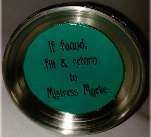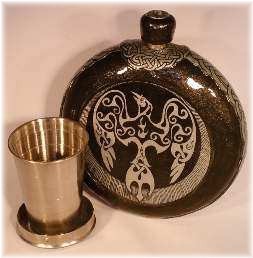Cabin Decor AND SO MUCH MORE
by Mistress Emerald












Anyone looking for the most wondrous clay overlays need look no further than e Clay Goddess.
Gypsy Spring began working with polymer clay in 2006. By 2007 she had run out of enough room in her small house to store her creations, and so her 'festival road show' began. Catering to the “discerning drunk”, Gypsy creates the most amazing clay-on-substrate art. If there's a way to drink out of it, she can decorate it.
Using a proprietary process, Gypsy is able to add intricate lines to her designs, which means Celtic borders and detailed images are always available. So are “property of ” statements on the bo om of mugs – so your beloved drink ware can find it's way back to you. What I found the most impressive was Gypsy's color gradient work. She calls it Ambra, and the blend from light to dark or metallic to plain is breathtaking e polymer base is usually 1/16” to 1/8” thick – but then comes the adornments. Gypsy’s cutouts and clay borders remind me of classic jasper frescos. She can also incorporate gems, Swarovski crystals and hanging chains to create one-of-a-kind show pieces.
Gypsy uses metal and glass substrates to create decorated tankards, flasks, cigar cases, bo les, goblets, chalices, switch plates and cell phone covers. She clear coats each piece for durability. In the case of glassbo om tankards - which have a nasty tendency to leak all over your fine garb - she inserts a decorative medallion that shows upward through the glass (so you see it when you drain your drink) and then seals the tankard so that it will never leak again.
One of the hallmarks of Gypsy's work is texture. If it doesn't feel good to the hand, it won't feel good to use. To that end, she incorporates many techniques, including sandblasting. Gypsy fondly remembers the blind couple who had a ball in her booth, because there was so much to 'look' at with their hands!
Gypsy sells at fairs and festivals in the Pacific Northwest, so you can find e Clay Goddess at the Sco ish Games in Woodland, CA, the Canterbury Renaissance Faire in Silverton, OR and the Midsummer Renaissance Faire in Bonny Lake, WA. Her prices vary depending on complexity, $55-$200 for a tankard, $55-$150 for a goblet, $45-80 for a flask. e chain chalices start at $100… and get expensive. You can reach Gypsy online at facebook.com/theclaygoddess. You can also email her at theclaygoddess2007@gmail.com. Custom orders are the same price as her regular merchandise, but book ahead for special events. During Gypsy's busy season, the turn around time can be 2-3 months.
That's all for now, my darlings.